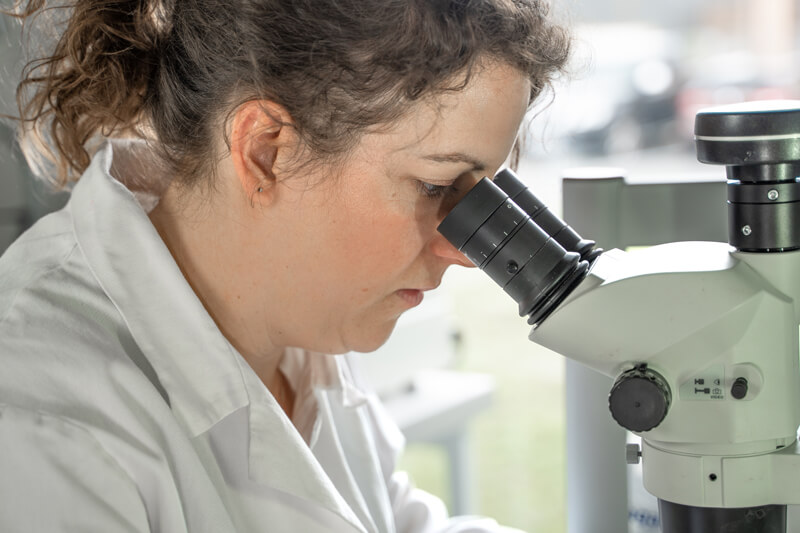
ANALYSIS OF STONE OBJECTS
Dating the stone is possible, but it is the formation of the rock that we will date and not its shaping, its carving. To decide on the age of the carving, we will need to couple different techniques such as optical microscopy, scanning electron microscopy (SEM), and micro-analysis (EDX). This multifactorial study is one of the specialties of CIRAM’s research teams.
The utility of dating a stone
It is important to differentiate between the dating of stone as a raw material and the age of the sculpture or artwork. Most of the time, it is indeed the chronology of the creation phase that is of interest. Therefore, it is not possible to use methods such as carbon dating to date minerals.
Dating is done by sample analysis in the laboratory. Stone is a robust material that degrades slowly over time, our studies are of interest for stone artworks that are at least 300 years old and can be up to several thousand years old.
Dating a stone work of art not only authenticates the object, but also characterizes the sculpture with a view to restoration.
Authenticating a STONE SCULPTURE
Authenticating a STONE SCULPTURE
CIRAM offers different analyses allowing the most accurate authentication of stone objects, whether marble, jade, sandstone, limestone, granite… Our method is based on complementary examinations which are:
- Analysis of the object’s constituent material
- Analysis of the degree and nature of mineral alteration
- Visualization of the internal structure and homogeneity of the object

Characterizing rock crystal, a Ciram exclusive
The analysis of rock crystal is exclusive to CIRAM laboratories. Rock crystal, agate, chalcedony, jasper, carnelian, onyx are very resistant siliceous rocks that do not alter over historical periods, unlike marble or sandstone for example. Because of this resistance, classical stone analyses do not work. So we have to do it differently.
Our engineers will measure the penetration of water into the rock crystal to depths of about one micrometer (one thousandth of a mm). This is done by detecting the hydrogen atoms in the water using ERDA (Elastic Recoil Detection Analysis) and RBS (Rutherford Backscattering Spectrometry) techniques. The more water has penetrated the material, the older the object will be revealed to be.

THE TECHNIQUES OF ANALYZING A STONE
An analysis according to the type of rock
Analysis of the stone’s composition is the first step in our analytical protocol. Our researchers will determine the different constituent crystals, in order to clearly identify the nature of the rock. This first level of investigation will help rule out fake stone carvings, for example.

The importance of rock alteration
Scanning electron microscopy (SEM) is at the heart of the analysis of a stone object. This method allows us to study the degree of alteration of the stone and the origin of this alteration.
The analysis of microsections and surface replicas under the electron microscope allows us to observe the alteration process of the rock by looking for, in particular:
- Differential dissolution
- Crystal amorphization
- Recrystallization of iron and/or manganese oxides
- Surface decohesion
- Presence of a weathering gradient
Surface deposits and tool marks
Our teams will be particularly interested in surface deposits, as their nature provides information about the history of the object. Are these deposits of natural origin and do they come from prolonged interaction with a natural burial environment, or is it an artificial patina deliberately applied to simulate the age of a stone sculpture?
Analysis of the tool marks will reveal the lapidary techniques used. Are they manual and traditional techniques, as can be expected on ancient objects, or are these traces the result of the use of mechanical power tools and modern materials.
All of these clues provide a complete of a stone sculpture, also allowing the identification of cleaning or restoration phases that do not contradict the antiquity of the objects.
X-ray radiography and structure homogeneity
X-ray radiography is used to assess the homogeneity of the object and to identify areas of possible restoration and assembly. This examination helps finalize the authentication of a stone sculpture.
The sometimes large size of stone sculptures is not a hindrance to our analyses, as CIRAM’s engineering and research teams offer in situ x-ray radiography using our portable equipment.
CIRAM world leader in dating and analysis of art objects
CIRAM Laboratories conducts a relevant and rigorous methodology in the analysis of stone artwork. We couple scientific analysis with the expertise of our specialists to authenticate, date, and characterize objects.
Dating stones is therefore far more complex than other materials. Methods like carbon-14 dating don’t work. But thanks to the observation and interpretation of our teams of scientists, it is possible to analyze and pronounce on the chronological compatibility of stone sculptures.
Discover other areas of CIRAM expertise:
